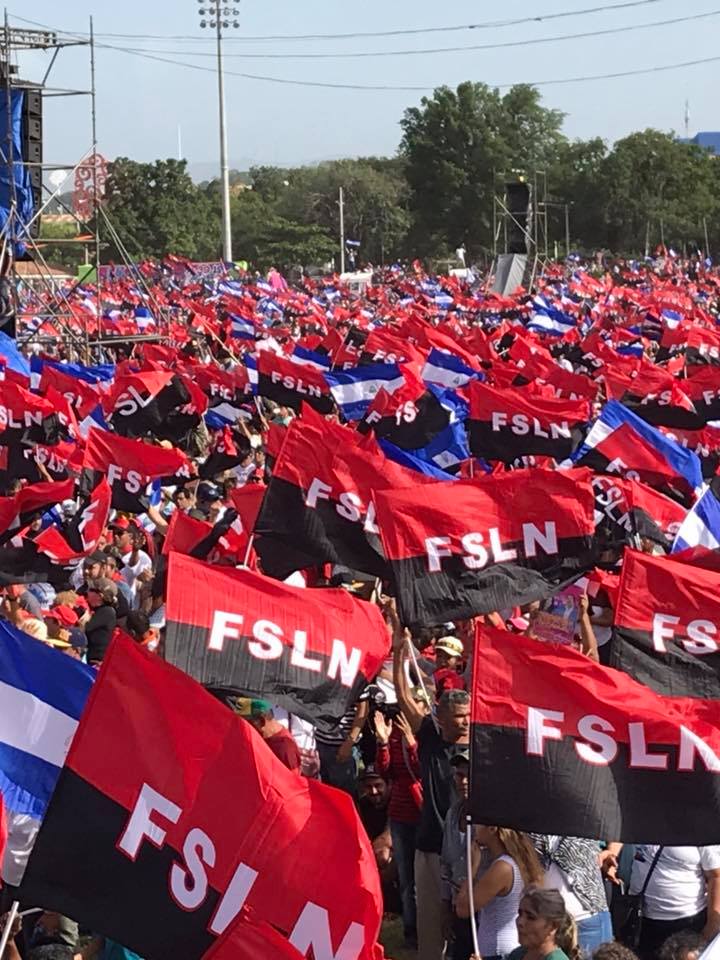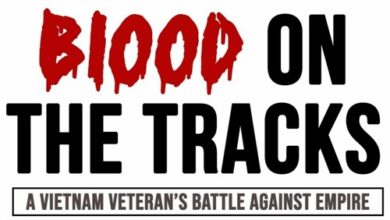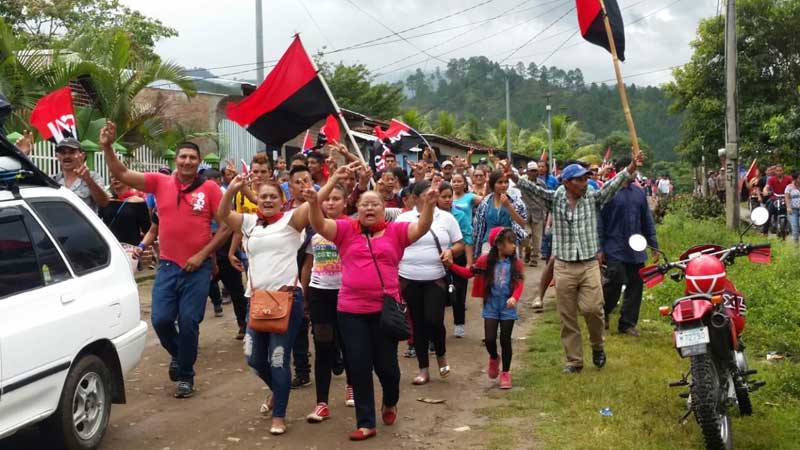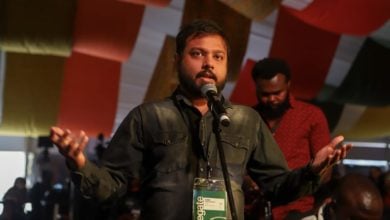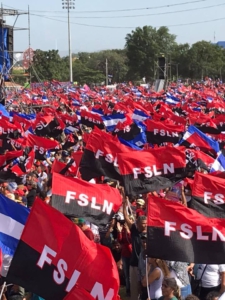
Originally published on Counterpunch.
When the smoke finally clears, if it ever clears here, the coverage of the recent events in Nicaragua will be looked upon as quite possibly the most effective, and equally sinister, misinformation campaigns ever waged upon a nation. The good news is that the Nicaraguan people, while initially confused by this campaign, have quickly caught on to what is really happening. Hopefully, we in the Global North will catch on soon.
Max Blumenthal, Thomas Hedges and I travelled to Nicaragua during the week of the annual celebration of the overthrow of the US-backed Somoza dictatorship on July 19, 1979. As we were reminded during our stay in Managua, 50,000 Nicaraguans (out of a total population of about 2.5 million) died in the struggle to overthrow Somoza in the late 1970’s. However, this was of little concern for the US, or the OAS which the US has always dominated.
Thus, in 1978, even as Somoza was attacking major cities with advanced weaponry supplied by the US, UK and Israel – weaponry which included “armored personnel carriers, Sherman tanks, U.S.-made troop transports and light observation helicopters equipped with machine guns and rockets, several two-engine, rocket-equipped Cessnas, artillery, and an awesome assortment of automatic weapons”– the most the OAS would do is agree to a US proposal for a political mediation in Nicaragua between Somoza and the “moderate” (i.e., non-Sandinista) opposition.
Similarly, as Noam Chomsky has noted, Nicaragua under the brutal Somoza regime warranted little coverage by the mainstream media. As he explains, “[i]n the ten years prior to the overthrow of the Nicaraguan dictator Anastasio Somoza in 1979, US television — all networks — devoted exactly one hour to Nicaragua, and that was entirely on the Managua earthquake of 1972. From 1960 through 1978, the New York Times had three editorials on Nicaragua. It’s not that nothing was happening there — it’s just that whatever was happening was unremarkable. Nicaragua was of no concern at all, as long as Somoza’s tyrannical rule wasn’t challenged.”
However, this all changed when the Sandinistas took over the Nicaraguan government and when the US began funding the Contras (largely former Somoza National Guardsmen) and their terror campaign against the Nicaraguan population. Then, the mainstream media worked hard to undermine the legitimacy of the Sandinistas and to downplay the criminal nature of the Contras. According to Fair & Accuracy in Reporting (FAIR), analyzing media coverage of the Contra War:
In many ways the media have functioned as a sieve for what Abraham Brumberg, former editor of the USIA journal Problems of Communism,described as a “flood of distortions, exaggerations and plain unvarnished lies about the Sandinistas that issue forth almost daily from the administration.”. . .
From the beginning, this administration has sought to focus media attention on every (real and imagined) peccadillo of the Sandinistas while downplaying the far worse human rights records of other Central American nations. Even after the signing of the regional peace plan, the media continued to reflect Reagan’s obsession by focusing primarily on Nicaragua. . . .
Meanwhile, Contra abuses were whitewashed by a propaganda blitz that hit America’s three most influential dailies . . . .
Fast forward to today, and the media, little concerned about Nicaragua since the end of the Contra war in 1990, and little impressed with the Sandinista government’s remarkable achievements in health care, poverty reduction, community policing, infrastructure development and economic growth since re-taking power in 2007, is now again covering Nicaragua on a daily basis. The media’s current interest has been piqued by the prospect that the Sandinista government might be overthrown, and the media is hell-bent upon helping such a process along with coverage even more one-sided than it gave to the Contra War.
For its part, the OAS, still dominated by the US, has also been activated into overdrive, lending a hand in the regime-change effort by blaming all of the violence happening in Nicaragua on the government while ignoring the violence of the opposition. At the same time, the OAS, and the press as well, also ignore the violence committed by US client states such as Colombia which is engaging in the wholesale slaughter of peace advocates, human rights leaders, land rights activists and indigenous and Afro-Colombian leaders. In this way, one is given the impression that it is the Nicaraguan government which is somehow a unique evil in Latin America.
In many ways, the story being put forward by the mainstream media and the OAS is the exact opposite of what is really happening in Nicaragua. Thus, far from the mainstream media tale of peaceful protesters being mowed down by a brutal regime, what we heard on our trip to Nicaragua more closely jibes with the analysis of Atilio Boron, acclaimed Argentine intellectual and winner of UNESCO’s International José Marti Prize, who explains that, when they perceived a weakness in the Sandinista government after the initial announcement of mild social security reforms in mid-April, the right-wing “threw themselves with all their arsenal into the streets to overthrow Ortega. They transferred many of the mercenaries that staged the ‘guarimbas’ in Venezuela to Nicaragua and are now applying in Nicaragua the same recipe for violence and death taught in the CIA manuals [for the Contras].”
Of course, given that the National Endowment for Democracy (NED) – the successor to the CIA’s regime-change operations abroad – has provided millions of dollars to the groups leading the anti-government operations in Nicaragua and has indeed admitted to “laying the groundwork for insurrection,” this should be none-too surprising.
The case of Monimbo — a historic neighborhood in the town of Masaya, Nicaragua, and the last major area cleared of the opposition street barricades (or, tranques) — is quite instructive. While the mainstream media has invariably portrayed the tranques in such areas as being set up and manned by brave youths who were trying desperately to protect their neighborhoods from imminent police attack, residents tell a very different story.
We spent an hour with one resident of Monimbo, a former local Sandinista official, who had just come to Managua for the celebration of the 1979 Sandinista Triumph. She asked not to be named because she still fears reprisals by opposition forces in her town who have been targeting Sandinista loyalists for harassment, assault and even murder. This woman, who we shall call Maria, wept uncontrollably as she recounted how her neighborhood had been terrorized by those on the tranques who paralyzed the local economy, prevented free movement, burned down public buildings, ransacked shops and destroyed residents’ homes.
Every day, as Maria, a wife and mother of two children, went through the tranques to go about her day, she was harassed, intimidated and put in fear for her life and physical integrity. As she explained, “I was not afraid that they would kill me. I am not afraid of dying. What I was afraid of is that they would rape me.” Here, she was referring to other incidents in which rapes were carried out by people manning the tranques. As just one example, we learned of a female police officer who was kidnapped and raped by these forces over a three-day period.
Maria referred to those on the tranques as criminal elements who were well-supplied with water, food, weapons and even drugs. She then explained how she cried tears of joy when, on July 17, she saw government forces approaching her neighborhood to remove the tranques. She indeed referred to this act as one of “liberation” which finally brought her neighborhood relief after three months of virtual imprisonment.
And, far from fearing police activity in her neighborhood, she and her husband (who also wishes not to be named) felt frustration that the police had not acted more swiftly and resolutely to deal with the tranques. But, they explained, it was President Ortega’s orders for the police to remain in their barracks, and for residents not to take matters into their own hands, in order to avoid unnecessary bloodshed. And so, for three months, the police were locked down in their barracks, surrounded by the right-wing opposition forces who prevented water and food from reaching them. Indeed then, as Maria explained again with forceful tears, it was the police who were being laid siege to, and not the well-supplied protesters.
While Maria and many of her friends were prepared to fight the protesters destroying their town, and others like it, they heeded Ortega’s orders. In the end, they believe that Ortega was right to urge such restraint; that it was indeed such restraint, led by the disciplined Sandinistas, which saved many lives, preventing what has turned out to be possibly 300 dead from becoming possibly thousands dead. But you will never hear this in the mainstream press.
Similarly, while the mainstream press repeats the oppositions’ vague and unsubstantiated claims about government press censorship, it is in fact the extreme opposition which is censoring the press through violence. Thus, during our stay in Managua, we met with the staff of RadioYa!, a an independent, left-wing radio station which also happens to be the most popular radio station in the country and the most popular left-wing station in Latin America. The staff, now working out of a makeshift studio, is still in shock after their permanent radio station was burned to the ground by the right-wing opposition. Making it worse, 22 staff people, including a pregnant woman, were in the radio station when it was set ablaze. They were lucky to get out alive, but still live in fear of violent reprisals – so much so that some of them sleep in the station overnight for safety’s sake. As the staff explained, other left-wing media outlets have been similarly attacked, while no opposition outlets have been attacked. Moreover, they explained that we were the first Western reporters to bother to listen to their story.
We also visited the remnants of a credit union, named after Che Guevara, which had served poor and working people with small loans and with banking services which they would not otherwise be able to obtain because of their inability to keep significant funds in their accounts. This credit union too was burned down by the right-wing opposition, along with the computers and paper files inside. They even managed to destroy all of the vehicles on the property. Again, this was typical of the institutions targeted for destruction by the opposition – institutions which serve the poor and working class and which provide a social good to the community.
As another example, the opposition forces (most of whom were not themselves students) took over public universities, such as the National Autonomous University of Nicaragua (UNAN), trashed these universities, and prevented classes from being held. At the same time, the opposition did no harm to private universities.
All this, never discussed by the mainstream media, demonstrates the class nature of the opposition. It is aligned with the bourgeoisie against the working class, and has spent three months in an all-out assault upon working class institutions, individuals aligned with the Sandinista revolution and Sandinista symbols. In other words, the uprising by the opposition is not a revolution, but a US-backed counter-revolution, just as the Contra movement was in the 1980’s. And, the mainstream media has painted over the true nature of this opposition and their brutal tactics, just as it whitewashed the brutality of the Contras. That so many on the US left do not see this is truly disappointing.
The good news is that the Nicaraguan people are not fooled. After some initial confusion, they have now rallied around the Sandinista government. This was evidenced, as we witnessed, by the throngs who came out on July 19 with their red and black Sandinista flags to celebrate the victory over Somoza in 1979, and to celebrate the current victory over the right-wing.
This was also evidenced by the ubiquitous playing of the new hit song, “Daniel Se Queda” (Daniel Stays), a song written by Nicaraguan campesinos and demanding that Daniel Ortega remain as President even if it may hurt the opposition’s feelings. As the song’s chorus goes, “Even if it hurts! Even if it hurts! The Commander stays here. Daniel, Daniel, the town is with him.”
And, Nicaragua is undoubtedly better off with Daniel staying. For this proposition, I leave you again with the poetic words of Atilio Boron:
Conclusion: the fall of Sandinismo would weaken the geopolitical environment of the brutally attacked Venezuela and increase the chances for the generalization of violence throughout the region.
While in the Forum of Sao Paulo that just took place in Havana, I was able to delight in the contemplation of the Caribbean. There I saw, in the distance, a fragile little boat. It was handled by a robust sailor and, at the other end, there was a young girl. The helmsman looked confused and struggled to keep his course in the middle of a threatening swell. And it occurred to me that this image could eloquently represent the revolutionary process in Nicaragua, in Venezuela, Bolivia or anywhere.
The revolution is like that girl, and the helmsman is the revolutionary government. There is no human work safe from error; mistakes can be made that leave the helmsman at the mercy of the waves and endanger the life of the girl. To top it all, not far away was the ominous silhouette of a US warship, loaded with lethal weapons, death squadsand mercenary soldiers. How to save the girl? The helmsman could jump into the sea letting the boat sink, and with it the girl, delivering it to the mob of criminals thirsty for blood and ready to plunder the country, steal its resources and rape and then kill the young girl.
I do not see that as the solution. More productive would be that some of the other boats that are in the area approach the one in danger and make the helmsman stay on course. Sinking the boat that carries the girl of the revolution, or surrendering her to the U.S. ship, could hardly be considered revolutionary solutions.


